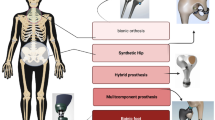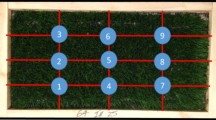Abstract
Background
The purpose of this study was to evaluate a potential risk of intraoperative contamination associated with clothing systems and surgeon’s motion in total joint replacement.
Methods
The airborne particle concentrations at different locations around a single operating surgeon wearing standard surgical gown (SG) or modern “space suit” (SS) were compared. The particles in the size of ≥0.5 μm (roughly corresponding to a mean diameter of squamous epithelial cells) were counted at the following three locations: (1) ≈10 cm inferior to the wrist; (2) ≈10 cm posterior to the feet; and (3) near the chest (operative field) under condition either with or without the surgeon’s motion (stepping in place at ~1 Hz).
Results
The difference in the surgical clothing systems did not significantly affect the mean particle counts detected near the wrist and chest (p = 0.307 and 0.155, respectively). However, the particle count near the feet was 154 times higher in SS than SG (4630 ± 2795 vs. 30 ± 23 N/F3, p = 0.023). The simple stepping of the surgeon with SS increased contaminants near the chest 31 times as compared to the condition without motion (1053 ± 709 vs. 34 ± 31 N/F3, p = 0.0032). Although the particle count was less affected by the motion in SG than SS, contaminants near the chest increased ten times after the stepping in the use of SG (p = 0.032).
Conclusion
The present results suggest that the intraoperative motion of a surgeon may considerably increase airborne particle/bacterial concentration in the operative field. This can be a much higher likelihood in SS rather than SG because of air blow-off from the incorporated cooling fan.




Similar content being viewed by others
References
Perl TM, Cullen JJ, Wenzel RP, Zimmerman MB, Pfaller MA, Sheppard D, Twombley J, French PP, Herwaldt LA (2002) Intranasal mupirocin to prevent postoperative staphylococcus aureus infections. N Engl J Med 346:1871–1877
Skråmm I, Moen AEF, Arøen A, Bukholm G (2014) Surgical site infections in orthopaedic surgery demonstrate clones similar to those in orthopaedic staphylococcus aureus nasal carriers. J Bone Jt Surg Am 96:882–888
Charnley J (1964) A clean-air operating enclosure. Br J Surg 51:195–202
Charnley J (1972) Postoperative infection after total hip replacement with special reference to air contamination in the operating room. Clin Orthop Relat Res 87:167–187
Lidwell O, Lowbury EJ, Whyte W, Blowers R, Stanley SJ, Lowe D (1982) Effect of ultraclean air in operating rooms on deep sepsis in the joint after total hip or knee replacement: a randomized study. Br Med J 285:10–14
Singh VK, Kalairajah Y (2009) Splash in elective primary knee and hip replacement: are we adequately protected? J Bone Jt Surg Br 91:1074–1077
Hooper GJ, Rothwell AG, Frampton C, Wyatt MC (2011) Does the use of laminar flow and space suits reduce early deep infection after total hip and knee replacement? The ten-year results of the New Zealand Joint Registry. J Bone Jt Surg Br 93:85–90
Young SW, Chisholm C, Zhu M (2014) Intraoperative contamination and space suits: a potential mechanism. Eur J Orthop Surg Traumatol 24:409–413
Gosden PE, MacGowan AP, Bannister GC (1998) Importance of air quality and related factors in the prevention of infection in orthopaedic implant surgery. J Hosp Infect 39:173–180
Alexander JW, Solomkin JS, Edwards MJ (2011) Update recommendations for control of SSI. Ann Surg 253:1082–1093
Pasquarella C, Pitzurra O, Herren T, Poletti L, Savino A (2003) Lack of influence of body exhaust gowns on aerobic bacterial surface counts in a mixed-ventilation operating theatre. A study of 62 hip arthroplasties. J Hosp Infect 54:2–9
Bohn WW, McKinsey DS, Dykstra M, Koppe S (1996) The effect of a portable HEPA-filtered body exhaust system on airborne microbial contamination in a conventional operating room. Infect Control Hosp Epidemiol 17:419–422
Shaw JA, Bordner MA, Hamory BH (1996) Efficacy of the Steri-Shield filtered exhaust helmet in limiting bacterial counts in the operating room during total joint arthroplasty. J Arthroplast 11:469–473
Blomgren G, Hambraeus A, Malmborg AS (1983) The influence of the total body exhaust suit on air and wound contamination in elective hip-operation. J Hosp Infect 4:257–268
McGovern PD, Albrecht M, Khan SK, Muller SD, Reed MR (2013) The influence of surgical hoods and togas on airborne particle concentration at the surgical site: an experimental study. J Orthop Sci 18:1027–1030
Namba RS, Inacio MCS, Paxton EW (2013) Risk factors associated with deep surgical site infections after primary total knee arthroplasty: an analysis of 56,216 knees. J Bone Jt Surg Am 95:775–782
Scaltriti S, Cencetti S, Rovesti S, Marchesi I, Bargellini A, Borella P (2007) Risk factors for particulate and microbial contamination of air in operating theatres. J Hosp Infect 66(4):320–326
Ayliffe GA (1991) Role of the environment of the operating suite in surgical wound infection. Rev Infect Dis 13:800–804
Author information
Authors and Affiliations
Corresponding author
Ethics declarations
Conflict of interest
The authors declare that they have no conflict of interest.
Ethical approval
This article does not contain any studies with human participants or animals performed by any of the authors, and all the experimental procedures were preliminary approved by the Institutional Review Board (IRB) of our institution.
Rights and permissions
About this article
Cite this article
Nakajima, D., Tateiwa, T., Masaoka, T. et al. Does modern space suit reduce intraoperative contamination in total joint replacement? An experimental study. Eur J Orthop Surg Traumatol 27, 1139–1143 (2017). https://doi.org/10.1007/s00590-016-1874-8
Received:
Accepted:
Published:
Issue Date:
DOI: https://doi.org/10.1007/s00590-016-1874-8




